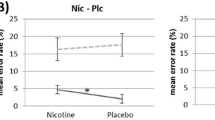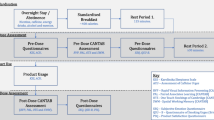Abstract
The purpose of this study was to assess the effects of acute nitotine administration, following a 12-h cigarette deprivation period, using a computerized performance assessment battery (PAB). The PAB was comprised of five tasks which were selected to reflect a variety of complex acquired behaviors, sometimes referred to as “cognitive performance”. Subjects were six healthy, male, cigarette smokers who practiced on the approximately 15 min PAB until their performance was stable across trials. In the training and baseline phase, subjects were tested following 5–30 min deprivation of cigarettes. Subjects were then tested following 12 h cigarette deprivation; 20 min before these sessions, subjects were given one piece of gum to chew. The gum contained 0, 2, or 4 mg nicotine, and it was chewed for 10 min at a rate of one chew every 2 s. There were two main findings: (1) when placebo (0 mg) gum was given, the time taken to complete the PAB tasks was significantly elevated above values obtained in the baseline condition; (2) compared to placebo, nicotine administration produced a dose-related decrease in the time taken to complete the tasks such that with either 2 or 4 mg, performance time was similar to that which occurred in the baseline cigarette smoking condition. Performance accuracy was not reliably affected by the experimental manipulations. These data indicate that the performance decrements observed in the placebo condition were specific to deprivation of nicotine following 12 h tobacco abstinence and are treatable using nicotine gum as a replacement formulation.
Similar content being viewed by others
References
American Hospital Formulary Services (1987) Drug information. 12:92. Miscellaneous autonomic drugs: nicotine polarcrilex. American Society of Hospital Pharmaceuticals, Bethesda, MD, pp 657–662
American Psychiatric Association (1987) Diagnostic and Statistical Manual of Mental Disorders (revised) (DSM-III-R) Am Psychiatr Assoc, Washington D.C.
Andersson A (1975) Effects of cigarette smoking on learning and retention. Psychopharmacologia 41:1–5
Benowitz NL (1986) The human pharmacology of nicotine. In: Kappell H (ed) Research advances in alcohol and drug problems, vol 9. Plenum Press, New York, pp 1–52
Elgerot A (1976) Note on selective effects of short-term tobaccoabstinence on complex versus simple mental tasks. Percept Mot Skills 42:413–414
Elgerot A (1978) Psychological and physiological changes during tobacco-abstinence in habitual smokers. J Clin Psychol 34:759–764
Federal Trade Commission (1983) Report of “tar”, nicotine and carbon monoxide of the smoke of 187 varieties of cigarettes. US Government Printing Office, Washington, DC
Grabowski J, Hall SM (eds) (1985) Pharmacological adjuncts in smoking cessation. NIDA Res Monogr 53. DHHS Pub. No. (ADM) 85-1333. Superintendent of Documents US Government Printing Office, Washington, DC
Haertzen CA, Hill HE, Belleville RE (1963) Development of the Addiction Research Inventory (ARCI): selection of items that are sensitive to the effects of various drugs. Psychopharmacologia 4:155–166
Heimstra NW, Bancroft NR, DeKock AR (1967) Effects of smoking upon sustained performance in a simulated driving task. Ann NY Acad Sci 142:295–307
Heimstra NW, Fallesen, JJ, Kinsley SA, Warner NW (1980) The effects of deprivation of cigarette smoking on psychomotor performance. Ergonomics 23:1047–1055
Henningfield JE, Stitzer ML, Griffiths RR (1980) Expired air carbon monoxide accumulation and elimination as a function of number of cigarettes smoked. Addict Behav 5:265–272
Herning RI, Jones RT, Bachman J (1983) EEG changes during tobacco withdrawal. Psychophysiology 20:507–512
Houston JP, Schneider NG, Jarvik ME (1978) Effects of smoking on free recall and organization. Am J Psychiatry 135:220–222
Hughes JR, Hatsukami D (1986) Signs and symptoms of tobacco withdrawal. Arch Gen Psychiatry 43:289–294
Jasinski DR (1977) Assessment of the abuse potential of morphinelike drugs (methods used in man). In: Martin WR (ed) Handbook of experimental pharmacology. Springer Berlin Heidelberg New York, pp 197–258
Kleinman KM, Vaughn RL, Christ TS (1973) Effects of cigarette smoking and smoking deprivation on paired-associate learning of high and low meaningful nonsene syllables. Psychol Rep 32:963–966
Myrsten A-L, Elgerot A, Edgren B (1977) Effects of abstinence from tobacco smoking on physiological and phsychological arousal levels in habitual smokers. Psychosom Med 39:25–38
Nemeth-Coslett R, Henningfield JE, O'Keefe MK, Griffiths RR (1987) Nicotine gum: dose-related effects on cigarette smoking and subjective rating. Psychopharmacology 92:424–430
Peeke SC, Peeke HVS (1984) Attention, memory, and cigarette smoking. Psychopharmacology 84:205–216
Pickworth WB, Herning RI, Henningfield JE (1986) Electroencephalographic effects of nicotine chewing gum in humans. Pharmacol Biochem Behav 25:879–882
Schmiterlow CG, Hansson E (1965) Tissue distribution of C14nicotine. In: von Euler US (ed) Tobacco alkaloids and related compounds. Pergamon Press, New York, pp 75–86
Schumaker SA, Grunberg NE (1986) Proceedings of the national working conference on smoking relapse. Health Psychol 5 [Supplement]
Shiffman SM (1979) The tobacco withdrawal syndrome. In: Krasnegor NA (ed) Cigarette smoking as a dependence process. NIDA Research Monogr 23, Bethesda, MD, pp 158–185
Thorne DR, Genser SG, Sing HC, Hegge FW (1985) The Walter Reed Performance Assessment Battery. Neurobehav Toxicol Teratol 7:415–418
Ulett JA, Itil IM (1969) Quantitative electroencephalogram in smoking and smoking deprivation. Science 164:969–970
Wesnes K, Warburton DM (1983) Effects of smoking on rapid information processing performance. Neuropsychobiology 9:223–229
Wesnes K, Warburton DM (1984a) Smoking, nicotine and human performance. In: Balfour DJK (ed) Nicotine and the tobacco smoking habit. Pergamon Press, Oxford, UK 133–152
Wesnes K, Warburton DM (1984b) The effects of cigarettes of varying yield on rapid information processing performance. Psychopharmacology 82:338–342
West RJ (1984) Psychology and pharmacology in cigarette withdrawal. J Psychosom Res 28:379–386
Author information
Authors and Affiliations
Rights and permissions
About this article
Cite this article
Snyder, F.R., Henningfield, J.E. Effects of nicotine administration following 12 h of tobacco deprivation: assessment on computerized performance tasks. Psychopharmacology 97, 17–22 (1989). https://doi.org/10.1007/BF00443406
Received:
Accepted:
Issue Date:
DOI: https://doi.org/10.1007/BF00443406




